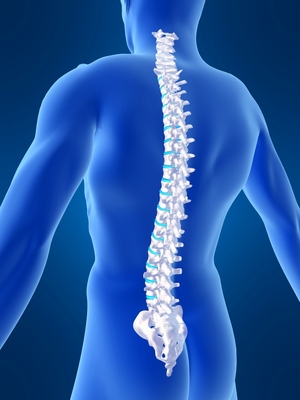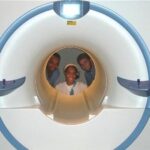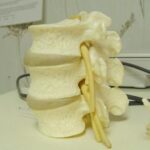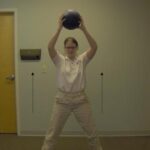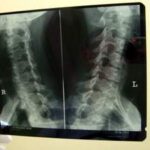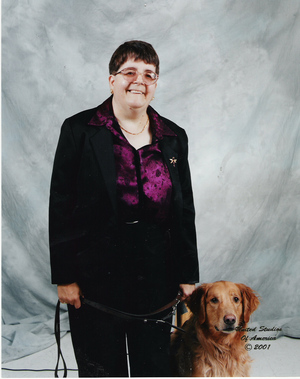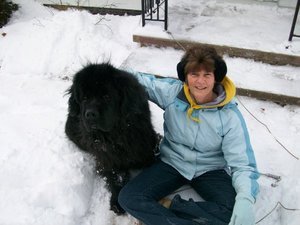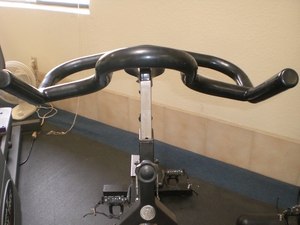A herniated disk is an injury to the soft cushioning disk between vertebrae. You can get a herniated disk at any location along your spine. This injury is not a spinal cord injury because it involves only the column around the spinal cord and not the spinal cord itself.
There are many names for herniated disk: ruptured disk, slipped disk, bulging disk, crushed disk, compressed disk, etc. These names are descriptions of the condition of the disk as it is seen after X-ray, MRI and or CT scan. For example, the herniated disk may look slipped or torn or compressed. All of these descriptions fall under the diagnosis of herniated disk.
Herniated disk injury is also not the same as degenerative disk disease, although a herniated disk may have begun to have some degeneration, as degeneration of disks is common in those who are aging or whose overall health is poor. By contrast, degenerative disk disease can occur in young people as well as older people and has an entirely different treatment regimen. These treatments may be several things including steroid injection and chiropractic manipulation.
The source of pain is different in a herniated disk injury than in degenerative disk disease. With a herniated disk the pain is nerve pain. In degenerative disk disease the source is the disk itself. This differentiation explains why the treatment approaches for the two conditions are different. Since a herniated disk causes nerve pain the sufferer will feel pain radiating outward and downward into the legs and sometimes into the feet. There may be tingling and numbness as well as muscle spasm and weakness.
An important fact about herniated disks is that they are particularly prone to re-injury, so treatment and adjustments to physical movements and lifting practices are greatly and equally important. Herniated disk injuries are surprisingly common, especially in on-the-job injuries involving improperly lifted heavy objects. An equally surprising number of herniated disks injuries that get proper treatment heal by themselves, sometimes in as little as four weeks, though others can take a long time. Those herniations that do not heal after four weeks require reevaluation.
The most important thing to know about having a herniated disk is that the beginning of the recovery process is to consult your doctor immediately for a diagnosis and treatment plan — remembering that naturopathic doctors can be very good at treating herniated disks — and get bed rest without doing any lifting or bending activities for the first four to seven days depending on the severity of the injury.
There are some things that you can do to augment the treatment plan your doctor develops that will help advance your recovery process. The first is to not clothing that puts pressure on the area of the herniation. For example, if the herniation is in the coccyx area, don’t wear slacks at all if you’re a woman and wear only loose fitting pleated pants or those with loosely elasticized waistbands if you’re a man. Essence oil massages are very good for injuries involving the nerves because they permeate tissues and also work on the bio-energy level. Simply massage the painful area with an essence oil, like Spikenard, Magnolia or Jasmine and then apply a hot compress.
It will important to your recovery process and to prevent re-injury to learn new ways of moving and doing everyday things. Learn to do the “golfer’s lift” as it takes the pressure off your vertebrae when you bend over to pick something up. Learn to carry things up at your chest and close to your body with one handed support underneath to support and distribute the burden of weight and reduce strain on your disks and vertebrae. Learn to turn bodily instead of twisting from your spine.
A herniated disk injury is painful and requires a patient, gentle recovery process with good medical diagnosis and treatment. But there is a good chance of natural recovery through proper care. And there are now many surgical options if surgery is your ultimate choice. And remember that the newest findings show that almost all herniated disks self-heal after about two years without devastating neurological complications developing during that period. So, if you have a herniated disk, see your doctor and consider seeing a naturopathic doctor, rest in bed, follow a treatment plan, don’t wear tight clothing, use essence oils massages followed by hot compresses, avoid bending and lifting and learn to bend and lift in new ways.
These Web sites have valuable information for herniated disk sufferers:
http://www.nlm.nih.gov/medlineplus/herniateddisk.html This has an overview with links to resaerch articles.
http://www.spine-health.com/topics/cd/d_difference/diff01.html This one has extensive information.
http://familydoctor.org/online/famdocen/home/common/brain/disorders/341.html This one has a simple but thorough discussion of disk injuries.
http://familydoctor.org/online/famdocen/home/common/brain/disorders/341.html This summarizes the latest treatment options for unresponsive disk injuries.
http://www.rosenbaumrehab.com/backinj.htm This one offers an overview of back, neck and brain injuries written by an M.D.
http://www.spine-health.com/topics/cd/back_injury/back_injury01.html This one teaches correct lifting.
http://www.spine-health.com/topics/cd/back_injury/back_injury02.html This one teaches the “golfer’s lift.”
http://www.spine-health.com/topics/cd/ergo/ergo04.html This one teaches correct turning and twisting.
Reference:
- www.nlm.nih.gov/medlineplus/herniateddisk.html This on gives an overview with reaeach articles.
